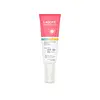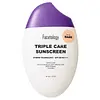What's inside
What's inside
 Key Ingredients
Key Ingredients

 Benefits
Benefits

 Concerns
Concerns

 Ingredients Side-by-side
Ingredients Side-by-side

Water
Skin ConditioningZinc Oxide
Cosmetic ColorantC12-15 Alkyl Benzoate
AntimicrobialC14-22 Alcohols
Emulsion StabilisingPropanediol
SolventHydroxyethyl Acrylate/Sodium Acryloyldimethyl Taurate Copolymer
Emulsion StabilisingBisabolol
MaskingC12-20 Alkyl Glucoside
EmulsifyingGlycerin
Humectant1,2-Hexanediol
Skin ConditioningTriethoxycaprylylsilane
Polyacrylate Crosspolymer-6
Emulsion StabilisingAllantoin
Skin ConditioningChlorphenesin
AntimicrobialPolyhydroxystearic Acid
EmulsifyingButylene Glycol
HumectantSilica
AbrasiveDibutyl Adipate
EmollientMadecassoside
AntioxidantBacillus Lysate
Skin ProtectingCaprylhydroxamic Acid
Aminomethyl Propanol
BufferingMaltodextrin
AbsorbentChlorophyllin-Copper Complex
AntioxidantGlucose
HumectantVitis Vinifera Leaf Extract
Skin ConditioningLactobacillus Ferment
Skin ConditioningPalmitoyl Pentapeptide-4
Skin ConditioningActinidia Polygama Fruit Extract
Skin ConditioningCamellia Sinensis Leaf Extract
AntimicrobialWater, Zinc Oxide, C12-15 Alkyl Benzoate, C14-22 Alcohols, Propanediol, Hydroxyethyl Acrylate/Sodium Acryloyldimethyl Taurate Copolymer, Bisabolol, C12-20 Alkyl Glucoside, Glycerin, 1,2-Hexanediol, Triethoxycaprylylsilane, Polyacrylate Crosspolymer-6, Allantoin, Chlorphenesin, Polyhydroxystearic Acid, Butylene Glycol, Silica, Dibutyl Adipate, Madecassoside, Bacillus Lysate, Caprylhydroxamic Acid, Aminomethyl Propanol, Maltodextrin, Chlorophyllin-Copper Complex, Glucose, Vitis Vinifera Leaf Extract, Lactobacillus Ferment, Palmitoyl Pentapeptide-4, Actinidia Polygama Fruit Extract, Camellia Sinensis Leaf Extract
Water
Skin ConditioningCyclopentasiloxane
EmollientEthylhexyl Methoxycinnamate
UV AbsorberCetyl Alcohol
EmollientTitanium Dioxide
Cosmetic ColorantGlycerin
HumectantNiacinamide
SmoothingTalc
AbrasiveCentella Asiatica Extract
CleansingNylon 6/12
AbsorbentCetearyl Alcohol
EmollientZinc Oxide
Cosmetic ColorantButyl Methoxydibenzoylmethane
UV AbsorberButylene Glycol
HumectantGlyceryl Stearate
EmollientOctocrylene
UV AbsorberPropylene Glycol
HumectantCeteareth-20
CleansingPEG-40 Stearate
EmulsifyingPolyacrylamide
Triethoxycaprylylsilane
Aluminum Hydroxide
EmollientEthylhexyl Salicylate
UV AbsorberArtemisia Vulgaris Extract
Skin ConditioningIsopropyl Titanium Triisostearate
EmollientMethylene Bis-Benzotriazolyl Tetramethylbutylphenol
UV FilterLecithin
EmollientMica
Cosmetic ColorantLaureth-7
EmulsifyingOryza Sativa Extract
AbsorbentOryza Sativa Germ Extract
EmollientDecyl Glucoside
CleansingAcetyl Glucosamine
Skin ConditioningCaprylhydroxamic Acid
Ethylhexylglycerin
Skin ConditioningBroussonetia Papyrifera Bark Extract
Skin ConditioningMorus Alba Bark Extract
Skin ConditioningRhus Semialata Extract
Skin ConditioningCamellia Japonica Flower Extract
EmollientCamellia Sinensis Leaf Extract
AntimicrobialMadecassoside
AntioxidantPyrus Malus Fruit Extract
Skin ConditioningCitric Acid
BufferingXanthan Gum
EmulsifyingTricholoma Matsutake Extract
Skin ConditioningTranexamic Acid
AstringentPhragmites Communis Extract
Skin ConditioningPoria Cocos Extract
Skin ConditioningPhenoxyethanol
PreservativePotassium Sorbate
PreservativeSodium Benzoate
MaskingCI 77491
Cosmetic ColorantCI 77492
Cosmetic ColorantCI 77499
Cosmetic ColorantWater, Cyclopentasiloxane, Ethylhexyl Methoxycinnamate, Cetyl Alcohol, Titanium Dioxide, Glycerin, Niacinamide, Talc, Centella Asiatica Extract, Nylon 6/12, Cetearyl Alcohol, Zinc Oxide, Butyl Methoxydibenzoylmethane, Butylene Glycol, Glyceryl Stearate, Octocrylene, Propylene Glycol, Ceteareth-20, PEG-40 Stearate, Polyacrylamide, Triethoxycaprylylsilane, Aluminum Hydroxide, Ethylhexyl Salicylate, Artemisia Vulgaris Extract, Isopropyl Titanium Triisostearate, Methylene Bis-Benzotriazolyl Tetramethylbutylphenol, Lecithin, Mica, Laureth-7, Oryza Sativa Extract, Oryza Sativa Germ Extract, Decyl Glucoside, Acetyl Glucosamine, Caprylhydroxamic Acid, Ethylhexylglycerin, Broussonetia Papyrifera Bark Extract, Morus Alba Bark Extract, Rhus Semialata Extract, Camellia Japonica Flower Extract, Camellia Sinensis Leaf Extract, Madecassoside, Pyrus Malus Fruit Extract, Citric Acid, Xanthan Gum, Tricholoma Matsutake Extract, Tranexamic Acid, Phragmites Communis Extract, Poria Cocos Extract, Phenoxyethanol, Potassium Sorbate, Sodium Benzoate, CI 77491, CI 77492, CI 77499
 Reviews
Reviews

Ingredients Explained
These ingredients are found in both products.
Ingredients higher up in an ingredient list are typically present in a larger amount.
Butylene Glycol (or BG) is used within cosmetic products for a few different reasons:
Overall, Butylene Glycol is a safe and well-rounded ingredient that works well with other ingredients.
Though this ingredient works well with most skin types, some people with sensitive skin may experience a reaction such as allergic rashes, closed comedones, or itchiness.
Learn more about Butylene GlycolCamellia Sinensis Leaf Extract is derived from the leaves of the tea plant. Black tea, green tea, and oolong tea are all harvested from this plant.
This ingredient has many skin benefits:
This ingredient contains polyphenols, a strong antioxidant. Antioxidants help fight off molecules that damage skin cells.
On top of that, the antioxidants in green tea neutralize free-radicals from the sun. This gives the skin some extra UV protection, but should not replace sunscreen.
Many components of tea have anti-inflammatory properties.
Polyphenols and L-theanine help soothe the skin and reduce irritation. The caffeine in Camellia Sinensis Leaf Extract helps calm inflamed blood vessels.
Other compounds found in tea include: Vitamin Bs, linoleic acid, magnesium, calcium, iron, and zinc.
Research has shown both drinking Camellia Sinensis Leaf Tea and applying it to the skin can help boost skin elasticity and hydration. Studies also show using tea extract may reduce sebum, or oil, production.
Learn more about Camellia Sinensis Leaf ExtractCaprylhydroxamic Acid is a chelating agent.
Chelating agents help prevent metal ions from binding to other ingredients. This helps prevent unwanted reactions and effects from using the product.
Caprylhydroxamic Acid is often used with natural antimicrobial products as an alternative to preservatives.
Learn more about Caprylhydroxamic AcidGlycerin is already naturally found in your skin. It helps moisturize and protect your skin.
A study from 2016 found glycerin to be more effective as a humectant than AHAs and hyaluronic acid.
As a humectant, it helps the skin stay hydrated by pulling moisture to your skin. The low molecular weight of glycerin allows it to pull moisture into the deeper layers of your skin.
Hydrated skin improves your skin barrier; Your skin barrier helps protect against irritants and bacteria.
Glycerin has also been found to have antimicrobial and antiviral properties. Due to these properties, glycerin is often used in wound and burn treatments.
In cosmetics, glycerin is usually derived from plants such as soybean or palm. However, it can also be sourced from animals, such as tallow or animal fat.
This ingredient is organic, colorless, odorless, and non-toxic.
Glycerin is the name for this ingredient in American English. British English uses Glycerol/Glycerine.
Learn more about GlycerinMadecassoside comes from the super popular skin-soothing ingredient, Centella asiatica. It is one of four active compounds found in the extract of Centella Asiatica.
Madecassoside has antioxidant, anti-inflammatory, and hydrating properties. It contains fatty acids, amino acids, beta-carotene, and phytochemicals.
One study found using Madecassoside with ascorbic acid helped reduce the signs of aging and improved skin hydration.
Learn more about MadecassosideTriethoxycaprylylsilane is a silicone used to bind and stabilize ingredients.
As an emulsifier, it helps prevent ingredients from separating. This can help elongate the shelf life of products.
Triethoxycaprylylsilane is often used to coat mineral sunscreens ingredients to help give a better feel. It also helps reduce oxidative stress in sunscreens.
Learn more about TriethoxycaprylylsilaneWater. It's the most common cosmetic ingredient of all. You'll usually see it at the top of ingredient lists, meaning that it makes up the largest part of the product.
So why is it so popular? Water most often acts as a solvent - this means that it helps dissolve other ingredients into the formulation.
You'll also recognize water as that liquid we all need to stay alive. If you see this, drink a glass of water. Stay hydrated!
Learn more about WaterZinc Oxide is a mineral broad-spectrum UV filter; it is the broadest UVA and UVB reflector approved by the FDA. It also has skin protectant and skin soothing properties.
Zinc oxide is one of the most effective broad-spectrum UV filters. It protects against UVB, UVAII, and UVAI. In comparison to its counterpart titanium dioxide, zinc oxide provides uniform and extended UVA protection.
Another great benefit? This ingredient is highly photostable so it won't degrade easily under sunlight.
A common myth is that mineral UV filters are widely believed to primarily reflect UV light.
However, modern research shows titanium dioxide absorbs UV radiation like chemical filters (~95% absorption & 5% reflection).
Zinc oxide has great skin soothing properties so you'll likely find this in sunscreens formulated for sensitive skin or babies/children. It is unlikely to cause "eye sting" like other sunscreen ingredients.
Regulatory agencies consider zinc oxide to be non-toxic and safe. It has also been shown to not penetrate the skin.
Unfortunately, this ingredient does leave a visible white cast. This is why mineral sunscreens are often less cosmetically elegant than chemical or hybrid ones.
In cosmetics, zinc oxide can be found in both non-nano and nano-sized forms. The nano version is used to reduce white cast and improve the texture of sunscreen formulas.
There are ongoing concerns surrounding nano-zinc oxide's impact on marine ecosystems and whether it can be absorbed into skin.
Regarding marine ecosystems and coral reefs, there is no conclusive evidence that any form of zinc oxide (or any other sunscreen ingredients) will cause harm. The science is still developing but many consumers are keeping a close eye on this issue.
Please note, many destinations have reef-safety sunscreen rules. For instance, the U.S. Virgin Islands advises all visitors to use non-nano mineral sunscreens.
There has also been some stir about whether micronized or nano zinc oxide has potential photoxicity and absorption through the skin/lungs.
An in-vitro (done in a test tube or petri dish) study demonstrated micronized zinc oxide to have potential phototoxicity. There's no need to fret; the EU Commission's Scientific Committee on Consumer Safety has stated, "The relevance of these findings needs to be clarified by appropriate investigations in vivo." Or in other words, further studies done on living organisms are needed to prove this.
Current research shows zinc oxide nanoparticles do not penetrate intact or sunburned skin. They either remain on the surface or in the outermost layer of dead skin (stratum corneum).
Zinc oxide is one of only two classified mineral UV filters with titanium dioxide being the other one.
Fun fact: Zinc has been used throughout history as an ingredient in paint and medicine. An Indian text from 500BC is believed to list zinc oxide as a salve for open wound. The Ancient Greek physician Dioscorides has also mentioned the use of zinc as an ointment in 1AD.
Learn more about Zinc Oxide